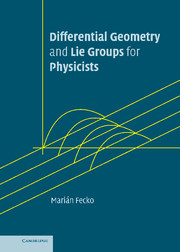Book contents
- Frontmatter
- Contents
- Preface
- Introduction
- 1 The concept of a manifold
- 2 Vector and tensor fields
- 3 Mappings of tensors induced by mappings of manifolds
- 4 Lie derivative
- 5 Exterior algebra
- 6 Differential calculus of forms
- 7 Integral calculus of forms
- 8 Particular cases and applications of Stokes' theorem
- 9 Poincaré lemma and cohomologies
- 10 Lie groups: basic facts
- 11 Differential geometry on Lie groups
- 12 Representations of Lie groups and Lie algebras
- 13 Actions of Lie groups and Lie algebras on manifolds
- 14 Hamiltonian mechanics and symplectic manifolds
- 15 Parallel transport and linear connection on M
- 16 Field theory and the language of forms
- 17 Differential geometry on TM and T *M
- 18 Hamiltonian and Lagrangian equations
- 19 Linear connection and the frame bundle
- 20 Connection on a principal G-bundle
- 21 Gauge theories and connections
- 22 Spinor fields and the Dirac operator
- Appendix A Some relevant algebraic structures
- Appendix B Starring
- Bibliography
- Index of (frequently used) symbols
- Index
22 - Spinor fields and the Dirac operator
Published online by Cambridge University Press: 06 July 2010
- Frontmatter
- Contents
- Preface
- Introduction
- 1 The concept of a manifold
- 2 Vector and tensor fields
- 3 Mappings of tensors induced by mappings of manifolds
- 4 Lie derivative
- 5 Exterior algebra
- 6 Differential calculus of forms
- 7 Integral calculus of forms
- 8 Particular cases and applications of Stokes' theorem
- 9 Poincaré lemma and cohomologies
- 10 Lie groups: basic facts
- 11 Differential geometry on Lie groups
- 12 Representations of Lie groups and Lie algebras
- 13 Actions of Lie groups and Lie algebras on manifolds
- 14 Hamiltonian mechanics and symplectic manifolds
- 15 Parallel transport and linear connection on M
- 16 Field theory and the language of forms
- 17 Differential geometry on TM and T *M
- 18 Hamiltonian and Lagrangian equations
- 19 Linear connection and the frame bundle
- 20 Connection on a principal G-bundle
- 21 Gauge theories and connections
- 22 Spinor fields and the Dirac operator
- Appendix A Some relevant algebraic structures
- Appendix B Starring
- Bibliography
- Index of (frequently used) symbols
- Index
Summary
• So far we have not mentioned yet another type of geometrical object, which may live on (some Riemannian) manifolds, the spinor field. These fields play an important role both in physics and in mathematics. The way in which Paul Dirac arrived at this concept may serve as an amusing (as well as highly instructive) example of how sometimes a discovery of truly the highest importance may originate from assumptions which are actually regarded as erroneous from a present-day perspective.
Dirac tried to find a relativistic formulation of quantum mechanics, i.e. to generalize the non-relativistic theory, based on the Schrödinger equation. This problem was also attacked before by several eminent physicists and their activity resulted in the equation nowadays known as the Klein–Gordon equation (16.3.7).
(In addition to Klein and Gordon it was independently discovered by other people, for example Fock. Amazingly, it was even discovered by Schrödinger himself before he found the equation that now bears his name. However, when he computed the energy spectrum of the hydrogen atom from the relativistic equation, he found that although it comes out “roughly correct,” it differs slightly from experiment at the finer level of accuracy. That is why he only published the non-relativistic approximation of the equation (leading just to the well-known “roughly correct” formula for the spectrum). This equation was then “relativistically generalized” by other authors.)
There were some serious problems with the physical interpretation of the Klein-Gordon equation resulting from the fact that it is a second-order equation in time (contrary to the Schrödinger equation, which is only first order in time).
- Type
- Chapter
- Information
- Differential Geometry and Lie Groups for Physicists , pp. 635 - 672Publisher: Cambridge University PressPrint publication year: 2006



